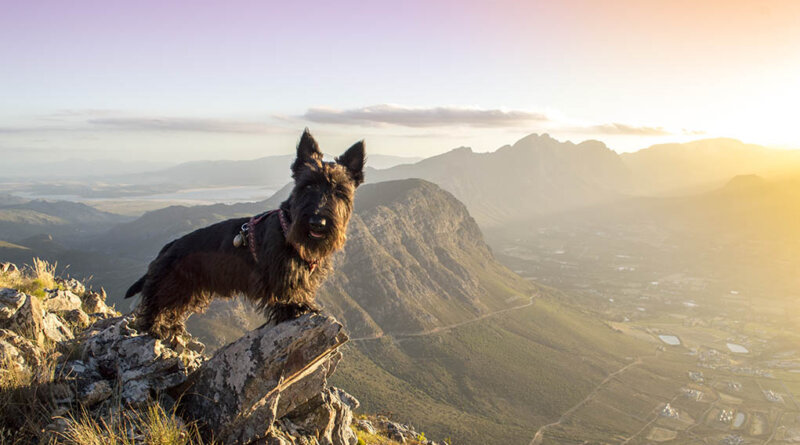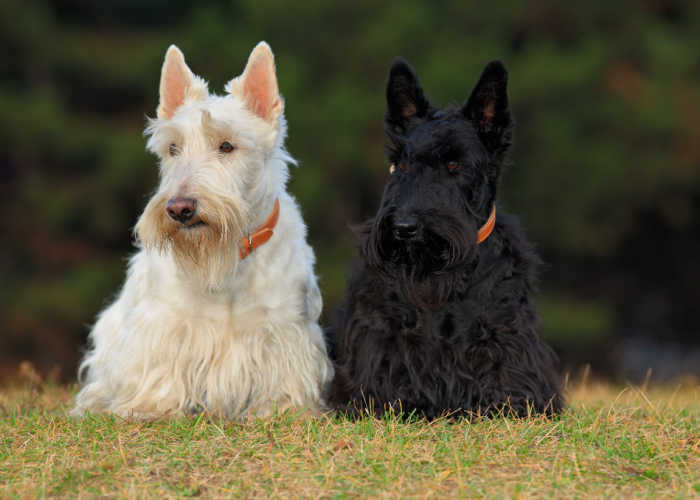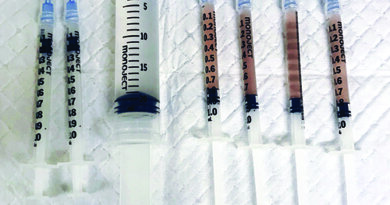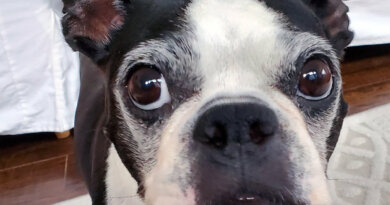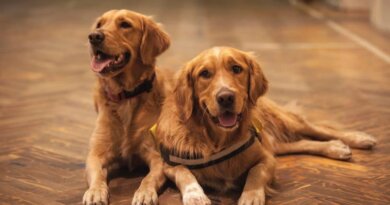Scottish Terrier Dog Breed Profile – Top Dog Tips
For small but independent dogs, we present you with the Scottish Terrier dog breed. Get ready because these dogs are stubborn and sensitive to praise and blame.
You’re probably familiar with this dog breed if you grew up watching Disney movies.
A Scottish Terrier named Jock starred in an animated film called Lady and the Tramp, which was released in 1995.
But they have been popular for some time now. They are one of the most recognizable breeds in the world.
Scottish Terriers are intelligent little dogs and true Terriers, making them also capable of being good watchdogs.
Today, there are more than 30 Terrier breeds that the AKC has recognized. Terriers are known to be small (except for Airedale Terriers) dogs with prominent personalities.
Terriers have different backgrounds and working styles. But they are aggressive and tenacious.
They have a few similarities in their personalities, such as being alert, courageous, and active.
They have lots of energy, meaning that you need to provide various outlets to avoid their destructive behavior.
These dogs have been known as Scottish Terriers since 1879, but they had multiple other names way back. This includes Aberdeen Terriers, Hard-Coated Scotch Terriers, and Die-Hard or Wire-Haired Terriers.
Before we get into their physical traits and temperaments, let’s first tackle the story behind the Scottish Terrier.
Scottish Terrier History
It is believed that the Old Scotch Terrier was the foundation for all terrier breeds today.
They may be extinct today, but they were described as strong, courageous, with lots of stamina, and could hunt even in rocky dens.
But Scotties were bred to be hunters. They would hunt rats, foxes, and badgers in Scottish Highlands, and they are considered one of the oldest Highland terriers.
Scottish Terriers, also known as Scotties, originated in Aberdeen, Scotland. They have been around for a long time.
However, their history is somehow uncertain or undocumented. Dog enthusiasts in the 1800s were arguing about their origin.
But no matter what their origin is, in the 17th century, England’s King James I grew fond of the breed and gave them as gifts all over France.
In 1883, the first Scottie imports reached America. And two years later, the first Scottish Terrier was AKC registered by a guy named Prince Charlie.
They became more popular in the 1930s and early 1940s. Celebrities such as Humphrey Bogart and Bette Davis owned Scotties Terriers in their time.
Physical Characteristics of the Scottish Terrier
Scottish Terriers are known to be small-sized dogs. Scotties average about 10 inches in height. On the other hand, male Scottish Terriers’ weight average is about 19 to 22 pounds.
Scotties are often thought of as black but they can also be grey or steel, brindle, or wheaten. Wheaten Scotties have a small resemblance with the West Highland White Terriers.
Scotties have two coats: the top coat and the bottom coat.
The top coat or overcoat is hard and wiry. Their bottom coat or undercoat, however, should be soft and dense.
If you’re not a fan of dog fur, luckily for you, Scottish Terrier doesn’t shed much since their hair just keeps on growing. But keep in mind that doesn’t mean they are easy to maintain.
Because if we’re being honest, this breed needs an extensive level of grooming. But we’ll get to that more later on.
The Temperament of the Scottish Terrier
Scottish Terriers are known to be big dogs with little bodies. These dogs are feisty and feisty.
They may not be very expressive with their emotions, but they are devoted and loyal to their family.
As they grow older, they often become moody. This can be a problem because Scotties tend to be aggressive over other pets and very stubborn in training.
As we’ve discussed above, Scotties are popular dogs. How popular, you ask?
They have been among the five most popular breeds not just in the U.S. but all over the world for decades.
Most Terrier breeds are very smart. But with that comes their independence, making them stubborn during training.
Scottish Farmers love these dogs as they are clever enough to figure things out all by themselves.
Living with a Scottish Terrier
Scotties are adaptable dogs. With proper training and socialization, they’ll be able to adjust to most homes.
Even though they are bred to hunt, it is not uncommon for them to live with small pets like cats, guinea pigs, rabbits, and more.
The key to this is to introduce them to each other properly. But it would be much better if they grew up together.
They are okay with all living arrangements, but just like any other dog, they are required to exercise daily.
These dogs are loving and make excellent companions. They are good with children as they are gentle and playful with them.
However, it’s best advised to supervise any interaction between your pet and children. As parents, we must teach them how to approach and how to act accordingly with their dog.
This is to avoid unwanted bites, scratches, ear pulling, or any harm between the two.
If you have a big yard, watch out for holes. Scotties loves digging holes and doesn’t know or care that you don’t like it.
Exercise and Training
If you’re planning to adopt a Scottish Terrier soon, you have to know that they require a certain amount of exercise per day.
Also, you have to be ready for their training as these two are both essential to dogs.
Scotties are active little dogs that need daily walks to maintain their physical and mental health. If you’re not a fan of walks, you can also exercise your pup through play.
Keep in mind that the lack of exercise and training can lead to behavioral problems. And we don’t want that headache in the future.
You can exercise your Scottish Terrier by hiking. Scotties love the outdoors as they were once hunters in rugged mountains.
Scottish Terriers are quite serious-natured. These dogs are independent, which means you’ll need a lot of patience.
It’s best to use positive reinforcement and reward-based training with Scotties. It’s also best advised to start their training at a young age.
The more time you spend with your Scottie, the more it strengthens your bond.
Health Care of Scottish Terriers
Scottish Terriers are healthy dogs. However, just like any other dog breed, they are prone to certain health conditions and problems.
But this doesn’t necessarily mean that your pup will get any of these health issues. However, as pet owners, we need to be aware of them.
If you’re looking to adopt a new dog, it’s best to adopt rather than shop. Research and find a reputable breeder that can give you health clearances of the puppy and its parents.
Below, we’ve listed down a few of the health problems your Scottie might encounter.
Scottie cramp
Scottie cramp is a common disorder in Scottish Terrier dog breeds. Fortunately, it is considered harmless.
Scottie cramp usually happens when the dog is stressed or overstimulated by exercise, anxiety, and stress.
At first, Fido will appear fine, but keep in mind the signs of this disorder. Symptoms include stiff cramped hind limbs, panting, stumbling, arching of the back, over-flexing of the back legs, and more.
There are also some instances where the dog will lose their ability to walk or run temporarily.
This condition is not a progressive disease which means Scotties can still live their best lives with this disorder.
Von Willebrand’s disease
Von Willebrand Disease is a bleeding disorder in dogs and humans that is caused by a lack of protein in the blood. This condition disables clotting when open wounds and may result in blood loss.
Some signs may be sustained bleeding after surgery or trauma. Another is hemorrhage from various body parts, including the nose, oral mucous membrane, urinary bladder, and vagina.
Owners should check with their veterinarians for tests and further consulting regarding precautionary measures they have to take with Scottish Terriers who have the disease.
If the disease has taken place and is not addressed immediately, it may become fatal for the dog.
Patellar Luxation
Patellar Luxation happens when the patella shifts its alignment out of the femur. This condition is a hereditary disorder in dogs.
That’s why it’s best to find a reputable and responsible breeder when it comes to adopting dogs.
This health issue can range from high to low levels of luxation, and each requires different cures.
Symptoms may include skipping and kicking off the leg. It’s best to consult with the vet for treatments, therapies, or procedures required to help a Scottish Terrier with this condition.
Remember not to breed Scotties who have these diseases. It’s best not to bring these despairing conditions to their offspring.
Craniomandibular osteopathy
Craniomandibular osteopathy is when the skull bones become irregularly enlarged while the puppy is still growing.
Signs often appear around four to eight months of age.
A usual symptom of this problem is when the puppy’s jaw and glands become swollen. It will be hard for them to open their mouths.
Other signs include excessive drooling, bulged-out eyes due to swelling within the skull, and fever.
A few other breeds that are prone to this disease are Cairn Terriers and West Highland White Terriers.
Grooming a Scottish Terrier
Even though Scotties don’t shed that much, they need immense grooming.
Again, Scottish Terriers have two coats. The top coat is hard and wiry, and the bottom coat is soft and thick.
If your Scottie likes to join dog shows, their coat needs to be groomed daily. But if your Scottie is just a regular pet, weekly coat grooming is enough.
Sounds easy enough? Well, that’s where you’re wrong. There are multiple grooming tools needed when it comes to brushing a Scottish Terrier.
For instance, if you’re going to brush their beard, you’ll need a wide-toothed comb and scissors for trimming.
The process of grooming for show dogs is different. They are groomed with a technique called stripping.
In this procedure, loose hairs are pulled out by using stripping knives or by hand.
All in all, brushing is crucial to Scottish Terriers because they tend to have bad reactions to fleas where they will chew themselves bald. It’s advised to brush them using a flea comb regularly.
Furthermore, their hair is not the only thing that needs brushing.
You should also brush your Scottie’s teeth at least two or three times a week. But if you can, daily brushing is encouraged to remove tartar buildup and bacteria.
Frequently Asked Questions
Do Scottish terriers bark a lot?
Scottish Terriers are intelligent and good family dogs. They only bark when necessary making them excellent watchdogs.
They tend to bark at strangers and show bravery in the presence of other dogs (especially large dogs).
Are Scottish terriers cuddly?
If you’re considering adopting a Scottish Terrier, you probably don’t know that these dogs are not cuddly. Just like humans, not all dogs show their love the same way.
Scotties, Malamut puppies, and Cairn Terriers are just a few dogs that rarely enjoy cuddles.
Are Scottish dogs hypoallergenic?
Yes, Scottish Terriers are hypoallergenic, meaning they are less likely to bother family members that are allergic to dogs.
Scotties have short medium coats that shed rarely. But they require moderate to high amounts of grooming and maintenance.
Scottish Terrier Dog Breed Profile: Summary
Scottish Terriers are intelligent and independent dogs. If you’ve never owned a dog before, you better be ready for this dog breed.
Even though they are known to be small-sized dogs, their personalities say otherwise.
Scottish Terriers originated in Aberdeen, Scotland. They were bred to be hunters. They were trained to hunt rats, foxes, rabbits, and more.
Adopting a Scottish Terrier puppy can be challenging for first-time owners as their independence can make them very stubborn in training.
But with positive reinforcement or reward-based training, combined with a lot of patience, Scotties can be an excellent addition to the family.
With proper socialization, living with a Scottish Terrier will be great.
They are okay with all types of living arrangements, so this gives you one less thing to worry about when getting one.
RELATED: YORKSHIRE TERRIER DOG BREED PROFILE

